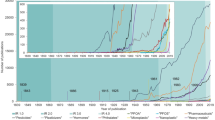Abstract
The aim of this study was to develop a method for quantitative measurement of urinary metabolites of pyrethroid (PYR) insecticides, trans-chrysanthemumdicarboxylic acid (CDCA) and 3-phenoxybenzoic acid (3-PBA), extracted from disposable diapers. This study was approved by the university ethics committees, and informed consent was obtained from all the parents for their children and from adult volunteers. After extraction of PYR metabolites in the absorber of diapers with 5 ml acetone, the metabolites in the eluents were extracted with tert-butyl methyl ether, derivatized with 1,1,1,3,3,3-hexafluoroisopropanol and analyzed by gas chromatography–mass spectrometry. The limits of quantitation (LOQs) were 0.55 μg/l for CDCA and 0.09 μg/l for 3-PBA in 2 ml urine extracted from diapers. Within-series and between-day precisions were <14% (CV%) over the concentration range of metabolites from 0.4 to 20.4 μg/l urine. When concentrations of each metabolite were measured with the developed method after pouring 2 ml urine, which was obtained from adults both in a general population and pest control operators, on diapers, good correlations were shown between the measured results and the concentrations measured directly for the respective urine with the conventional method (Spearman’s rank correlation coefficient 0.889 for CDCA and 0.989 for 3-PBA; n=27–28). The developed method would be applicable to epidemiological studies.
This is a preview of subscription content, access via your institution
Access options
Subscribe to this journal
Receive 6 print issues and online access
$259.00 per year
only $43.17 per issue
Buy this article
- Purchase on Springer Link
- Instant access to full article PDF
Prices may be subject to local taxes which are calculated during checkout









Similar content being viewed by others
References
Soderlund DM, Clark JM, Sheets LP, Mullin LS, Piccirillo VJ, Sargent D et al. Mechanisms of pyrethroid neurotoxicity: implications for cumulative risk assessment. Toxicology 2002; 171: 3–59.
WHO, Permethrin. Environmental Health Criteria Permethrin. World Health Organization: Geneva. 1990; 94.
Leng G, Gries W . Simultaneous determination of pyrethroid and pyrethrin metabolites in human urine by gas chromatography-high resolution mass spectrometry. J Chromatogr B Analyt Technol Biomed Life Sci 2005; 814: 285–294.
Ueyama J, Saito I, Kamijima M . Analysis and evaluation of pyrethroid exposure in human population based on biological monitoring of urinary pyrethroid metabolites. J Pest Sci 2010; 35: 87–98.
Japan Household Insecticide Industry Association 2006 Available at: http://www.sacchuzai.jp/images/gairon.pdf in Japanese.
Nouyaku-Youran, Japan Plant Protection Association 2009 in Japanese.
Olsson AO, Baker SE, Nguyen JV, Romanoff LC, Udunka SO, Walker RD et al. A liquid chromatography—tandem mass spectrometry multiresidue method for quantification of specific metabolites of organophosphorus pesticides, synthetic pyrethroids, selected herbicides, and deet in human urine. Anal Chem 2004; 76: 2453–2461.
Baker SE, Olsson AO, Barr DB . Isotope dilution high-performance liquid chromatography-tandem mass spectrometry method for quantifying urinary metabolites of synthetic pyrethroid insecticides. Arch Environ Contam Toxicol 2004; 46: 281–288.
Leng G, Gries W, Selim S . Biomarker of pyrethrum exposure. Toxicol Lett 2006; 162: 195–201.
Hu Y, Beach J, Raymer J, Gardner M . Disposable diaper to collect urine samples from young children for pyrethroid pesticide studies. J Expo Anal Environ Epidemiol 2004; 14: 378–384.
Fortin M-C, Bouchard M, Carrier G, Dumas P . Biological monitoring of exposure to pyrethrins and pyrethroids in a metropolitan population of the Province of Quebec, Canada. Environ Res 2008; 107: 343–350.
Schettgen T, Koch HM, Drexler H, Angerer J . New gas chromatographic-mass spectrometric method for the determination of urinary pyrethroid metabolites in environmental medicine. J Chromatogr B Analyt Technol Biomed Life Sci 2002; 778: 121–130.
Graebing P, Chib JS . Soil photolysis in a moisture- and temperature-controlled environment. 2. Insecticides. J Agric Food Chem 2004; 52: 2606–2614.
Abu-Qare AW, Abou-Donia MB . In vitro metabolism and interactions of pyridostigmine bromide, N,N-diethyl-m-toluamide, and permethrin in human plasma and liver microsomal enzymes. Xenobiotica 2008; 38: 294–313.
Ueyama J, Kimata A, Kamijima M, Hamajima N, Ito Y, Suzuki K et al. Urinary excretion of 3-phenoxybenzoic acid in middle-aged and elderly general population of Japan. Environ Res 2009; 109: 175–180.
Thomas KA . 6-Sulfatoxymelatonin collected from infant diapers: feasibility and implications for urinary biochemical markers. Biol Res Nurs 2010; 11: 288–292.
Lombardero N, Casanova O, Behnke M, Eyler FD, Bertholf RL . Measurement of cocaine and metabolites in urine, meconium, and diapers by gas chromatography/mass spectrometry. Ann Clin Lab Sci 1993; 23: 385–394.
Liu L, Xia T, Guo L, Cao L, Zhao B, Zhang J et al. Expressing urine from a gel disposable diaper for biomonitoring using phthalates as an example. J Expo Sci Environ Epidemiol 2012; 22: 625–631.
Becker K, Seiwert M, Angerer J, Kolossa-Gehring M, Hoppe HW, Ball M et al. GerES IV pilot study: assessment of the exposure of German children to organophosphorus and pyrethroid pesticides. Int J Hyg Environ Health 2006; 209: 221–233.
Ueyama J, Saito I, Kamijima M . Analysis and evaluation of pyrethroid exposure in human population based on biological monitoring of urinary pyrethroid metabolites. J Pestic Sci 2010; 35: 87–98.
Acknowledgements
We are grateful to Dr. Kenji Takagi and Ms. Naoko Hirosawa for their helpful advice in the course of this study. This work was supported in part by Grants-in-Aid for Scientific Research (236890234, 20310035 and 21659153) from the Japan Society for the Promotion of Science.
Author information
Authors and Affiliations
Corresponding authors
Ethics declarations
Competing interests
The authors declare no conflict of interest.
Rights and permissions
About this article
Cite this article
Saito, S., Ueyama, J., Kondo, T. et al. A non-invasive biomonitoring method for assessing levels of urinary pyrethroid metabolites in diapered children by gas chromatography–mass spectrometry. J Expo Sci Environ Epidemiol 24, 200–207 (2014). https://doi.org/10.1038/jes.2013.31
Received:
Accepted:
Published:
Issue Date:
DOI: https://doi.org/10.1038/jes.2013.31
Keywords
This article is cited by
-
A sensitive and efficient procedure for the high-throughput determination of nine urinary metabolites of pyrethroids by GC-MS/MS and its application in a sample of Japanese children
Analytical and Bioanalytical Chemistry (2018)



